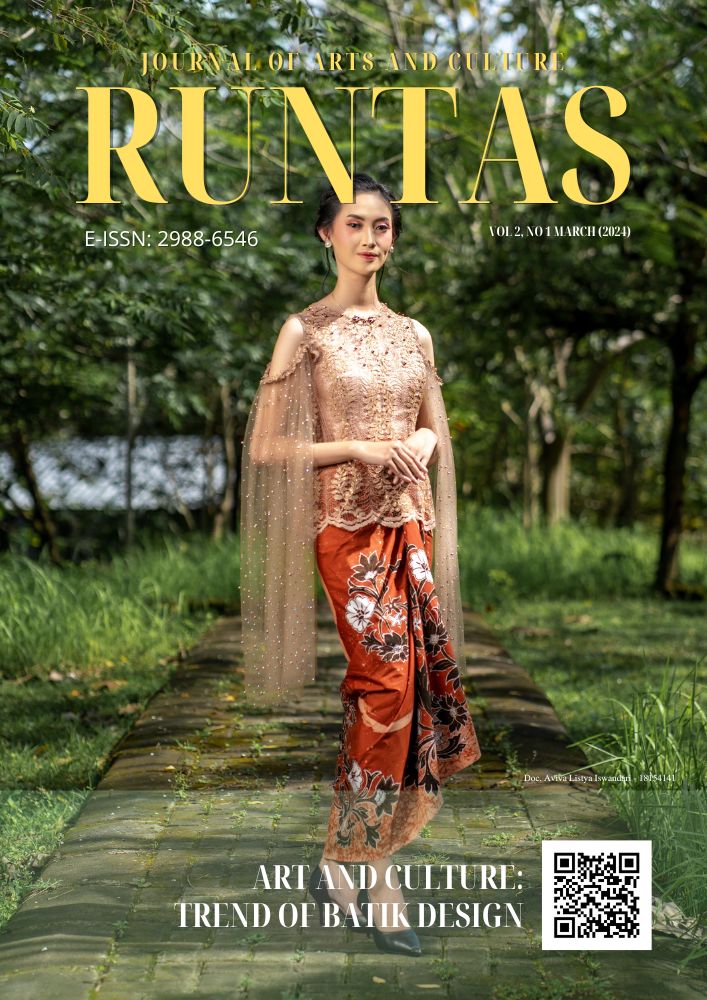GIRLS PARTY DRESSES WITH CEMPAKA FLOWER BATIK MOTIFS
DOI:
https://doi.org/10.33153/runtas.v2i1.4867Keywords:
Batik Tulis, Cempaka flower, Fashion clothesAbstract
The purpose of creating this work is to apply the Cempaka Flower motif into party dresses for girls. The methods used in making this work include expression, technique, and creation. The process of making this work consists of: the initial process using the batik tulis technique, then proceed with the coloring process in the form of dyed caps with synthetic dyes, namely with remasol dye, and using silk cotton fabric that is smooth and soft, therefore it is comfortable to use for girls’ party fashion works. The creation of this work resulted in four different types of girls' party dresses for ages 6-12 years. In this work, there are four different titles for each work that has been made, namely Lalita, Arabelle, Nayara, and Wening. Each of which has the meaning and expectations of the creator for each work created. The meaning of the work inspired by the cempaka flower is to present the leadership spirit of a woman, have a beautiful shape and smell good, present a woman who has a beautiful and charming appearance and has a strong character and a very attractive personality. The presence of a woman with a leadership spirit is able to present a nurturing feeling like the long petals of a chrysolite flower and are able to cover many people and other things. The end result of the creation of this work is that it is suitable for girls' party dresses aged 6-12 years and is suitable for attending birthday parties, garden parties, and various other formal events.
Downloads
References
Aditya, Wahyu Ashri, and Zelika Mega Ramadhania. 2019. “Artikel Ulasan: Kandungan Dan Aktivitas Farmakologi Tanaman Cempaka Kuning (Michelia Champaca Linn.).” Farmaka 16 (3): 10–19.
Desiningrum Ratri, Dinie. 2012. “Buku Ajar I.” Psikologi Perkembangan, no. Psikologi Anak: 245.
Dwajani dan Shanbhag, Tara. 2009. “Michelia Champaca: Aktivitas Penyembuhan Luka Pada Tikus Yang Mengalami Imunosipres.”
Fitri, Arifana. 2018. “Bunga Cempaka Putih Dalam Penciptaan Keramik Dekoratif Fungsional,” Nomor 11.
Hamzuri. 1985. “Batik Klasik.”
Julianto S, Tatang. 2016. “Minyak Atsiri Bunga Indonesia.”
Kahairudin, Zamroni. 2015. “Mempercantik Pekarangan Rumah Dengan Tanaman Obat.” http://www.satujam.com/mempercantik-pekarangan-rumah-dengan-tanaman-obat/.
Mushofi, Adzan. 2016. “Perancangan Program Event Pelatihan Membatik Di Batik Komar.”
Purnomo, MAJ. 2006. “Batik Sebagai Salah Satu Media Komunikasi Dalam Upacara Adat Tradisi Jawa,” 90.
Puspitawati, Hesti. 2009. “Pembuatan Busana Pesta Remaja Dengan Aksentuasi Ruffles.”
SPGustami. 2007. Butir-Butir Mutiara Estetika Timur: Idedasar Penciptaan Seni Kriya Indonesia. yogyakarta: prasista.
Tapsell, L.C., Hemphill, I., Cobiac, L., Patch, C.S., Sullivan, D.R., Fenech, M., Roodenrys, S., Keogh, J.B., Clifton, P.M., Williams, P.G., Fazio, V.A., dan Inge, K.E. 2006. “Health Benefits of Herbs and Spices: The Past, The Present, The Future. US National Library of Medicine. National Institutes of Health. Maryland.”
valentina C, Vischa. 2016. “Pengaruh Jenis Interfacing Terhadap Hasil Jadi Lengan Belimbing (Starfruit Sleeve) Pada Busana Pesta Anak Menggunakan Bahan Taffeta” 05 Nomor: 41.
Wikananda, I Dewa Ayu Rayna Nareswari, Made Agus Hendrayana, and Komang Januartha Putra Pinatih. 2019. “Efek Antibakteri Ekstrak Ethanol Kulit Batang Tanaman Cempaka Kuning (M. Champaca L.) Terhadap Pertumbuhan Staphylococcus Aureus.” Jurnal Medika 8 (5): 2597–8012.
Yuliati, Dewi. 2010. “Mengungkap Sejarah Dan Motif Batik Semarangan.”









